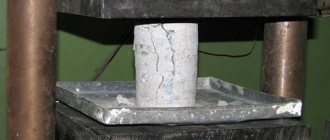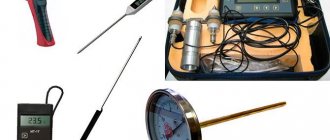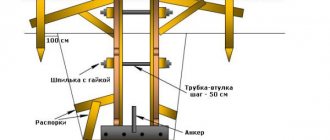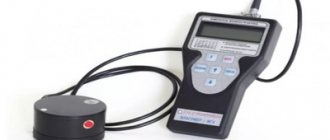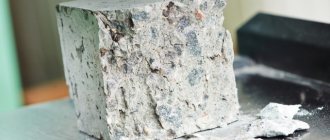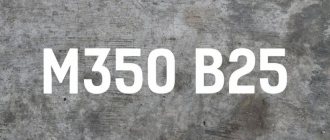- home
- Concrete Production
- Working with Concrete
Reading time: 11 minutes
3601
Non-destructive testing of concrete is a group of material testing methods, thanks to which it is possible to determine its technical characteristics without violating the integrity and obvious deformations. Determining the strength of a concrete monolith is a prerequisite for quality control of concrete and reinforced concrete products/structures during the production process.
Non-destructive testing of concrete strength makes it possible to identify all the most important values that directly affect the performance characteristics of the monolith and the safety and service life of products. The strength of a concrete monolith is influenced by many factors - such as the quality and proportions of the components, compliance with the mixture production technology, pouring conditions, correct drying, etc.
The strength of concrete is determined by its grade - for example, grade M400 can withstand a maximum load of around 400 kg/cm2, grade M500 - 500 kg/cm2, etc.
Typically, testing concrete for strength involves applying a control load to the hardened material, which is aimed at destroying the integrity of the structure. In this way, it is determined what maximum load values concrete can withstand, for what conditions it is suitable, and in what structures it can be used.
Destructive methods involve taking concrete samples from the monolith being examined or preparing control samples from a liquid mixture, and then destroying them. In addition, there are non-destructive methods that do not involve deformation and obvious damage to the structure of the material.
Basic methods of testing concrete for strength:
- Destructive methods
– use control samples, which are prepared and harden in the same way as the structure (or are removed from the monolith), and act on them with different forces. This is the most accurate test.
- Non-destructive indirect methods
– ultrasound examinations, shock pulse and elastic rebound methods. Strength is assessed indirectly through other parameters (ultrasound speed, for example), the error in the data obtained can be 30-50%.
- Non-destructive direct methods
– this can be tearing off a metal anchor (pre-embedded in concrete), using special equipment (measurement by chipping an edge, etc.).
When determining the strength of concrete, a variety of devices, special tools, data tables, etc. are used. Thanks to this, it is possible to obtain accurate information and reliable research results.
- 1 Non-destructive technologies for monitoring concrete strength
- 2 Testing of concrete by non-destructive testing GOST 17624-2012
- 3 Types of tests: table of values
- 4 Conclusion
Non-destructive technologies for monitoring concrete strength
Testing concrete using a non-destructive method involves assessing the condition of concrete structures through the analysis of various factors that affect strength, diameter of reinforcement, thickness of the protective layer, humidity, thermal conductivity, adhesion, etc. This type of research is especially relevant in cases where the characteristics of the concrete monolith and reinforcement are not known, but the scope of control is large.
This group of methods makes it possible to carry out research both in the laboratory and directly on the construction site and even during operation.
The main advantages of non-destructive testing:
- Maintaining the integrity of the structure being tested.
- Possibility to avoid the need to organize laboratory assessment directly at the construction site.
- Full preservation of the operational properties of buildings and structures.
- Quite a wide scope of application.
Despite the fact that there are a lot of methods and methods for studying liquid and hardened concrete, there are also many characteristics, the main property and indicator is strength. The scope of application and operating conditions, reliability and durability of the structure depend on strength. So, for example, if the concrete is frost-resistant and plastic when poured, with the best versatile characteristics, but not strong enough to withstand the design loads, the building will simply collapse.
Strength is a determining factor of concrete and must be checked very carefully. All tests are carried out on the basis of GOSTs: 22690-2015, 17624-2012 (inspection procedure), 18105-2010 (general inspection rules are described). The use of non-destructive methods involves the use of mechanical methods (indentation, chipping, tearing, impact) and ultrasonic examination.
The study of non-destructive testing of concrete is carried out according to a schedule, necessarily at the age established by the project or as necessary. Thanks to the research, it is possible to evaluate the tempering/stripping strength and compare the obtained real indicators of the material properties with the passport ones.
Non-destructive testing methods used:
- Direct (local destruction)
– chipping an edge, tearing off with chipping, tearing off a metal disc.
- Indirect
– elastic rebound, shock impulse, the use of plastic deformation, as well as the ultrasound method.
Local destruction conventionally refers to non-destructive methods. Their main advantage is the reliability and accuracy of the results. Tests are regulated by GOST 22690-2015.
Direct non-destructive methods for monitoring the strength of concrete:
- Separation with chipping
– the force required to destroy concrete in the process of tearing out an anchor is estimated. Among the advantages, it is worth noting the high level of accuracy, the presence of calibration dependencies in accordance with GOST, among the disadvantages - the inability to use for assessing densely reinforced and thin-walled structures, and labor intensity.
- Rib chipping
– the force required to chip the concrete in the corner of the structure is measured. Typically, the method is used to determine the strength of linear structures (square columns, piles, support beams). The main advantages of the method are ease of implementation, no need for preliminary preparation, disadvantages - it is not applicable to concrete with a layer of more than 2 centimeters and damaged monolith.
- Metal disc separation
– record the force that destroys concrete at the moment the metal disk is torn away from it. The method was often used in Soviet times, but today it is practically not used due to restrictions in terms of temperature conditions. Advantages: you can check densely reinforced structures, low level of labor intensity, disadvantages - the need for preliminary preparation (discs are glued to the surface of the concrete monolith 3-24 hours before the start of the test).
The main disadvantages of local destruction for measuring the strength of concrete are the need to calculate the depth of the reinforcement, high labor intensity, partial damage to the surface of the monolith, which can (albeit insignificantly) affect the performance properties.
Shock-impulse methods are more productive, but they only test the top layer of concrete 25-30 millimeters thick, so their use is limited. The surface must be cleaned, the damaged layer must be removed, and the graduated dependences of the devices must be brought into full compliance with the actual strength of the monolith according to the results of tests in the press of control batches.
To measure the strength of concrete, the shock impulse method is often used - the most common option, which makes it possible to determine the class of concrete by performing studies at various angles to the surface, taking into account the elasticity and plasticity of the material.
The striker with a spherical striker, thanks to a spring, hits the surface of the concrete, while the impact energy is spent on its deformation, a crater appears (plastic deformations) and a reactive force (elastic deformations).
The electromechanical converter converts the mechanical energy of the executed blow into an electrical impulse; real results are obtained in units of determining compressive strength. For research, a Schmidt hammer is used.
Advantages of the method: simplicity, compact equipment, ability to set the class of the material, disadvantages - low accuracy due to determining the strength of the layer up to 5 centimeters.
Features of the elastic rebound method:
- The tests use sclerometers - special spring hammers with spherical stamps. Due to the spring system, a free rebound after impact is realized. The path of the striker during rebound is recorded using a scale with an arrow.
- The strength of the material is determined by graduated curves that take into account the position of the hammer, because the magnitude of the rebound directly depends on the direction.
- The average research value is calculated based on the data of 5-10 measurements taken; the distance between impact sites should be at least 3 centimeters.
- The measurement range of the methods is 5-50 MPa, special instruments are used.
- Main advantages: simplicity/speed of research, ability to evaluate the strength of densely reinforced products. Disadvantages: determination of concrete strength is carried out in a surface layer 2-3 centimeters deep, checks need to be done often and a lot.
Testing the strength of concrete using the plastic deformation method is the cheapest method that determines the hardness of the concrete surface by measuring the mark left by a steel rod/ball that is built into a hammer. The hammer is placed in a perpendicular plane to the surface of the monolith and a couple of blows are made. The imprints on the concrete and the striker are measured. The obtained data is recorded, the average value is sought, and the characteristics of the concrete surface are determined from the resulting ratio of the sizes of the prints.
A device for research using the method of plastic deformation works by indenting a stamp with impact or static pressure. Static pressure devices are rarely used; impact devices (spring/hand hammers, pendulum devices with a disk/ball stamp) are more often used.
The following requirements are put forward: the diameter of the ball is at least 1 centimeter, the hardness of the steel of the dies is at least HRC60, the disk is at least 1 millimeter thick, the impact energy is 125 N or more. The method is simple, suitable for densely reinforced structures, fast, but is used to determine the strength of concrete of a maximum grade of M500.
In addition, there are other non-destructive testing methods - infrared, acoustic, vibration, electric potential method, etc. But they are used less frequently; shock impulse, tear-off with chipping, and ultrasound are considered basic.
The most difficult is considered to be the control of structures that are exposed to aggressive environments (chemical in the form of acids, salts, oils, thermal in the format of high/low temperatures, atmospheric - carbonization of the top layer).
When conducting an examination, by tapping and visually, by wetting with a phenolphthalein solution, they look for a layer with a damaged structure, remove it in the control area, and clean it with sandpaper. Then the strength is determined by sampling or local destruction methods. In the case of using ultrasonic and shock-pulse devices, the surface roughness of the monolith should be a maximum of Ra 25.
Advantages of the method
Testing concrete using a non-destructive method allows you to achieve the following advantages:
- maintaining the integrity of controlled structural elements;
- the possibility of conducting research directly at the existing facility;
- no adverse effects on the performance of the building as a result of the test procedure;
- versatility and ease of use.
The methods used allow us to obtain the most accurate results, subject to compliance with the procedures established by the standards, and the involvement of certified experts with specialized equipment.
Testing of concrete by non-destructive testing GOST 17624-2012
An ultrasonic method for testing the strength of concrete is to record the speed of waves passing through a monolith. There is end-to-end ultrasonic sounding with the installation of sensors on different sides relative to the test sample, as well as surface sounding with the mounting of sensors on one side. The through method makes it possible to control the strength of not only the surface, but also the deep layers of the structure.
Ultrasonic monitoring devices are used for flaw detection, checking the quality of concreting, identifying the depth of reinforcement in concrete and the monolith itself. The devices make it possible to repeatedly examine different shapes and continuously monitor the decrease/increase in strength.
The relationship between the grade strength of concrete and the speed of ultrasound is influenced by the composition and volume of the filler, the consumption of the binder, the method of preparing the concrete solution, and the degree of its compaction. The main disadvantage of the method is the significant error in the research results.
Taking into account the high speed of passage of ultrasound in a monolith of material (about 4500 m/s), the calibration dependence of the wave speed and the strength of concrete is calculated in advance for each test composition. Using two graded relationships for a specific concrete and an unknown composition can lead to a big error.
The main feature of testing the strength of concrete using a non-destructive ultrasonic method is the ability to carry out mass studies of products of any shape repeatedly, and effectively continuously monitor the increase/decrease in structural strength online.
Hammer Rebound Method
The Schmidt jackhammer is a surface hardness tester for which an empirical correlation has been established between strength and rebound force (number).
The only known tool that uses the rebound principle for testing concrete is the Schmidt hammer, which weighs about 1.8 kg and is suitable for both laboratory and field work. It consists of a spring hammer mass that slides over a piston inside a tubular body.
The hammer is pressed against the concrete surface by a spring, and the rebound distance is measured on a scale. The test surface may be horizontal, vertical or at any angle, but the instrument must be calibrated in this position.
Calibration can be done using cylinders (6 by 12 inches) of the same cement and aggregate that will be used in the job. The concrete cylinders must be closed and held securely in the compression machine to test the strength of concrete. And only after several measurements are taken, the average value represents the compressive strength of the concrete.
Limitations and Benefits
The Schmidt hammer provides an inexpensive, simple and rapid method of obtaining a concrete strength index, but accuracy within ±15–20% is only possible for specimens cured and tested under the conditions for which calibration curves have been established.
The results are influenced by factors such as surface smoothness, sample size and shape, concrete moisture content, type of concrete and coarse aggregate, and degree of surface carbonation.
Types of tests: table of values
Each technology for non-destructive testing of concrete strength has its own ranges of values and recommended values for compressive strength. Maximum measurement values are regulated by instrument manufacturers and empirical results. For more convenient interpretation of research data, ranges and errors are summarized in tables.
The strength of concrete is usually determined on areas of the monolith surface of the required area, where there are no visible damages and amorphous delaminations; the ambient temperature must be above zero.
